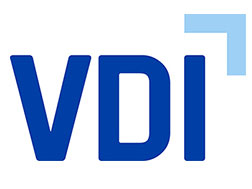Past Events
2022
With the VDI Autonomous Driving Challenge (VDI ADC), the young talent competition for autonomous driving model cars on a scale of 1:8, ambitious teams were finally be able to show again on May 20 what potential lies in modified RC model cars. After the successful start in March 2020 and last year's Corona forced break, 5 Teams took the challenge competed against each other on the "Campus of Ideas - Accenture Office" in Munich, the new base of the main sponsor of the VDI ADC 2022.
The racetrack was located in the 312 m² Campus Max, a light-flooded hall with a room height of two stories, equipped with an oversized video wall. After an exciting day of competition, the winner was Team IFM Racing from Kempten University of Applied Sciences. And although there could only be one first place in the end, we see winners in all participants who mastered this challenge.
The challenge 2022 as video
Sponsors

Teams
Team RoboTHIx, Technische Hochschule Ingolstadt
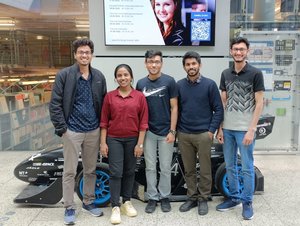
Team RoboTHIx includes six participants (not all pictured): Krishna Chaitanya Tirumalaraju, Usharani Tati, Anand Krishnan, Basith Sidhique, Kaushal Bharatbhai Patel, Junaid Raza.
The team is supervised by Prof. Dr. Martin Ebert.
Team SAM, University of Applied Sciences Munich
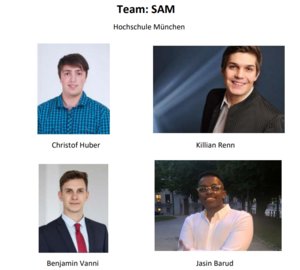
Team SAM from the Munich University of Applied Sciences starts with the four participants: Christof Huber, Killian Renn, Benjamin Vanni Jasin Barud. The team is supervised by Prof. Dr. Lars Wischhof
Team Taco, University of Applied Sciences Offenburg
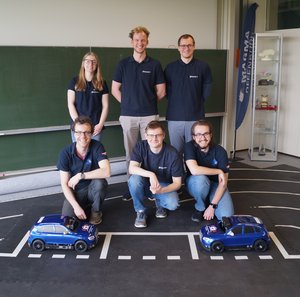
Team Taco from the University of Applied Sciences Offenburg with the six participants: Franka Weirich, Arian Braun, Anton Kesy, Rico Schillings, Etienne Muser, Dominik Friedrich.
The team is supervised by Prof. Dr. Klaus Dorer
Team UDEmobil, University of Duisburg-Essen
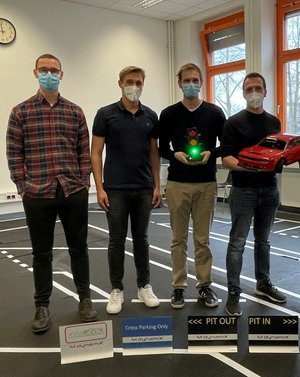
Team UDEmobil from the University of Duisburg-Essen starts with the four participants: Alexander Hoffman, Yannik Thelen, Tom Schickel, Simon Krämer.
The team is supervised by Prof. Dr. Frédéric Etienne Kracht
Team IFM, University of Applied Sciences Kempten
Team IFM - Racing from the IFM - Institute for Driver Assistance and Connected Mobility, University of Applied Sciences Kempten, with the two participants: Bonifaz Stuhr, Johann Haselberger.
The team is supervised by Prof. Bernhard Schick.
Team ADC, University of Applied Sciences Bochum
Team ADC from the University of Applied Sciences Bochum Campus Velbert / Heiligenhaus with the four participants: Sven Wallner, Rene Schirm, Kilian Wittke, Jan Weber. Team picture follows.
The team is supervised by Prof. Dr.-Ing. Markus Lemmen
Congratulations to the winning team "IFM - University of Applied Sciences Kempten"

With bits and bytes on the race track
Report from Fritz Münzel
On May 20, 2022, at the Campus of Ideas in Munich, the young talent competition in the field of autonomous driving, the VDI Autonomous Driving Challenge (VDI ADC), finally entered the next round. Five teams from all over Germany thrilled the audience with their modified RC model cars during the all-day competition and showed what is possible in the field of autonomous driving in the miniature range.
Every competition needs rules and regulations. For the ADC, the VDI Bezirksverein München Ober- und Niederbayern (VDI District Association Munich Upper and Lower Bavaria) has drawn up a comprehensive set of rules which, on 36 pages, not only defines the course and the various judging disciplines, but also sets out technical parameters for the model cars [1].
The key point is the use of a particular design of the Japanese Kyosho, which has been on the market for a long time and has a well service network in Europe. With this a whole host of technical parameters have already been defined, from the engine power and the sensors to the on-board computer and the operating software, taking into account the latest state of the art. The drive motor alone, with a maximum output of just under 150 W is already astonishing. The organizer wanted to prevent with this standardization that the competing teams don't run up to the cost-intensive material battle for better technical equipment such as engine power, tires, batteries, etc. A certain version of NVIDIA is prescribed as the on-board computer, for which there are already a lot of programs for image evaluation from the industrial sector. But the teams were allowed to deviate from the standard equipment, as long as the performance of the variant is not greater than that of the standard solution. Thus one finds also the use of the microcomputer from Arduino, which is very common and for which a large number of software solutions exists. As basic software ROS had to be used, a standardized control software, as it is also used in "real" autonomous driving cars. On this basis, the participants could create their own software modules. The design of these modules contributed significantly to the success of the project.
In a first evaluation, the "static discipline", the teams had to present their solutions and take part in the discussion. A total of five teams competed in six disciplines (see table). The individual disciplines were weighted differently. Faultless parking and driving on time were rated very highly, less important was the acceleration race and the pursuit race. The discipline "Overtaking" was not actually planned, but the participants during the competition choosed to try it anyway with some amazing results, which were astonishing and were met with great applause.
All participants gave their best, but only one can win, and that was the team from Kempten University of Applied Sciences. The secret of their success lay not so much in individual perfect sequences, as rather in the experience of the participants
in control engineering and robotics as well as from the successful participation in the last ADC. In the pursuit race, however, the group had to accept the deduction of points, because the control loop that defines the distance to the vehicle in front was probably set a little too sharp. And so their Porsche pushed it a few times. Could this be the first step toward more fun with autonomous driving? Maybe for some drivers but the deduction of points in the real life is rather painful.
Rankings
1. IFM – University of Applied Sciences Kempten
2. UDE mobil – University Duisburg-Essen
3. TACO – University of Applied Sciences Offenburg
4. SAM – University of Applied Sciences Munich
5. ADC – University of Applied Sciences Bochum/Campus Velbert Heiligenhausen

